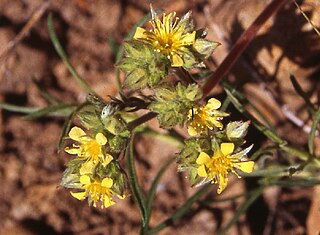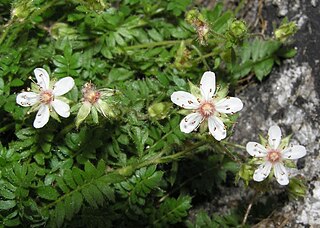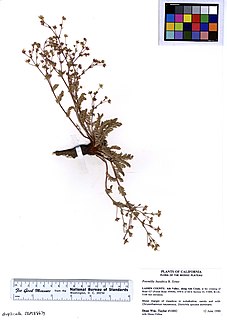
Paeonia californica is a perennial herbaceous plant of 35–70 cm high, that retreats underground in summer, and reoccurs with the arrival of the winter rains. It has lobed leaves, elliptic (cup-shaped) drooping flowers with dark maroon-colored petals, and many yellow anthers. It flowers mostly from January to March, and later develops two to five fruits per flower. Its common name is California peony and it is sometimes also referred to as wild peony. This peony is an endemic of southwestern California (USA), where it is not rare, and northernmost Baja California (Mexico). It grows on dry hillsides in the coastal sage scrub and chaparral communities of the coastal mountains of Southern and Central California, often as an understory plant.

Gilia brecciarum is an annual flowering plant in the phlox family (Polemoniaceae), known by the common name Nevada gilia or break gilia.

Ivesia aperta is a species of flowering plant in the rose family known by the common name Sierra Valley mousetail.

Ivesia callida is a rare species of flowering plant, in the rose family, known by the common name Tahquitz mousetail. It is a small perennial herb which forms matted patches of hanging foliage on cliff faces. The leaves are strips of oval-shaped green leaflets. Each leaf is up to 7 centimeters long and has several pairs of hairy, glandular leaflets. The thin, green, hanging stems grow up to 15 centimeters long and bear an inflorescence of several flowers. Each flower has five hairy, pointed sepals and five round to oval white petals. The center of the flower contains twenty stamens with disc-shaped anthers and several pistils.

Ivesia gordonii is a species of flowering plant in the rose family known by the common name Gordon's mousetail. It is native to the mountain ranges of the western United States from California to Montana. This is a tuft-forming perennial plant which grows in rocky areas. It produces a clump of erect stems and tail-like leaves. Each leaf is a thick, rounded strip of small, green, lobed leaflets which overlap. The thin, naked stems reach 5–25 centimetres (2.0–9.8 in) tall. They bear hairy, glandular inflorescences of clustered flowers. Each flower has five yellow-green triangular sepals and five tiny spoon-shaped yellow petals. In the mouth of the flower are five stamens and a few thready pistils.

Ivesia lycopodioides is a species of flowering plant in the rose family known by the common name clubmoss mousetail, or clubmoss ivesia. It is native to the Sierra Nevada and to regions east of the range in California. It may also be found beyond the state line into Nevada. This is a perennial herb which grows in the crevices of rock ledges in the mountains and in wet high-elevation meadows. It produces a rosette of flat to cylindrical leaves up to 15 centimeters long, each of which is made up of many tiny, lobed leaflets. The stems may grow erect or drooping to 30 centimeters long and each holds an inflorescence of clustered flowers. Each flower has hairy, greenish triangular sepals and much larger oval-shaped petals of bright yellow. In the center of the flower are usually five stamens and several pistils. There are three subspecies.

Ivesia webberi is a species of flowering plant in the rose family known by the common names wire mousetail and Webber's ivesia. It is native to the United States, where it occurs in the northernmost part of the Sierra Nevada and the adjacent Modoc Plateau in California, its range extending just into Nevada.

Allium cratericola is a species of wild onion known by the common name Cascade onion. It is endemic to California, where is an uncommon member of the flora in several of the state's mountain ranges, including the northern and southern California Coast Ranges, the western Transverse Ranges, Klamath Mountains, and the Sierra Nevada foothills. Its range covers much of the state, from Riverside County to Siskiyou County.
Astragalus austiniae is a species of milkvetch known by the common name Austin's milkvetch. It is native to the Sierra Nevada of California and Nevada in the vicinity of Lake Tahoe. It is a plant of the alpine climate of the high mountains, where it tolerates exposed areas.

Astragalus bolanderi is a species of milkvetch known by the common name Bolander's milkvetch. It is native to western Nevada and parts of the Sierra Nevada in California. It grows in dry, rocky habitat on mountain and plateau.
Astragalus pseudiodanthus is a species of milkvetch known by the common name Tonopah milkvetch. It is native to the Great Basin deserts of Nevada and eastern California, such as the Tonopah area, where it grows in sandy habitat.

Astragalus pulsiferae is a species of milkvetch known by the common name Ames's milkvetch. It is native to California and Nevada, and it is known but rare in Washington. It is known from many habitat types, including mountains and plateaus.
Ivesia unguiculata is a species of flowering plant in the rose family known by the common name Yosemite mousetail.

Acmispon argophyllus, synonym Lotus argophyllus, is a species of legume native to California and northwest Mexico. It is known by the common name silver bird's-foot trefoil or silver lotus.
Perideridia lemmonii is a species of flowering plant in the family Apiaceae known by the common names Lemmon's yampah and tuni. It is native to the western United States, where it is known from southeastern Oregon, western Nevada, and the mountains of eastern California. It grows in meadows, forests, and other habitat. It is a perennial herb approaching one meter in maximum height, its slender, erect stem growing from usually a single small tuber about 1.5 centimeters long. Leaves near the base of the plant have blades up to 30 centimeters long divided into one or two pairs of leaflets, each of which may be subdivided. The inflorescence is a compound umbel of many spherical clusters of small white flowers. These yield ribbed, round or oblong-shaped fruits each under half a centimeter long.

Phacelia davidsonii is a species of phacelia known by the English name Davidson's phacelia named by Asa Gray for the discoverer of this annual plant, Anstruther Davidson, a Scottish naturalist who emigrated from Scotland to Los Angeles, California, in the late nineteenth century. This native forb occurs in southern California and southern Nevada, where it grows in mountains and foothills in chaparral and woodland habitats. In California, this herb is found in the Southern Sierra Nevada, Transverse Ranges, and Peninsular Ranges.
Potentilla pseudosericea is a species of cinquefoil known by the common names silky cinquefoil and Mono cinquefoil. It is native to the Sierra Nevada of California and mountain ranges just to the east, where its distribution extends into Nevada. It grows in rocky mountainous habitat. It is a small plant forming mats or tufts in rock cracks and talus, its short stem growing from a caudex. The leaves are generally palmate, divided into five leaflets. The leaflets are deeply lobed along the edges and woolly in texture, coated in white or silvery hairs. The inflorescence is a cluster of a few yellow flowers with petals around 3 millimeters long each.
Trifolium bolanderi is a species of clover known by the common names Bolander's clover and parasol clover.

Trollius laxus is a rare flowering plant species in the buttercup family, Ranunculaceae. It is native to North America and is considered to have two subspecies, one with a distribution is the east and one in the west. Common names for Trollius laxus include American globeflower and American spreading globeflower. The American Globeflower, Trollius laxus is an endangered species of flowering plants Native to Northeastern United States. This species of plants is limited in range by their ability to exclusively survive in wetlands and marshes. Thus, clusters of the species are constantly threatened by the ever-changing hydrology of the range they are confined to.

Potentilla basaltica is a species of flowering plant in the rose family known by the common names Soldier Meadows cinquefoil and basalt cinquefoil. It is endemic to a small area of the Modoc Plateau and Warner Mountains in northeastern California and northwestern Nevada.















